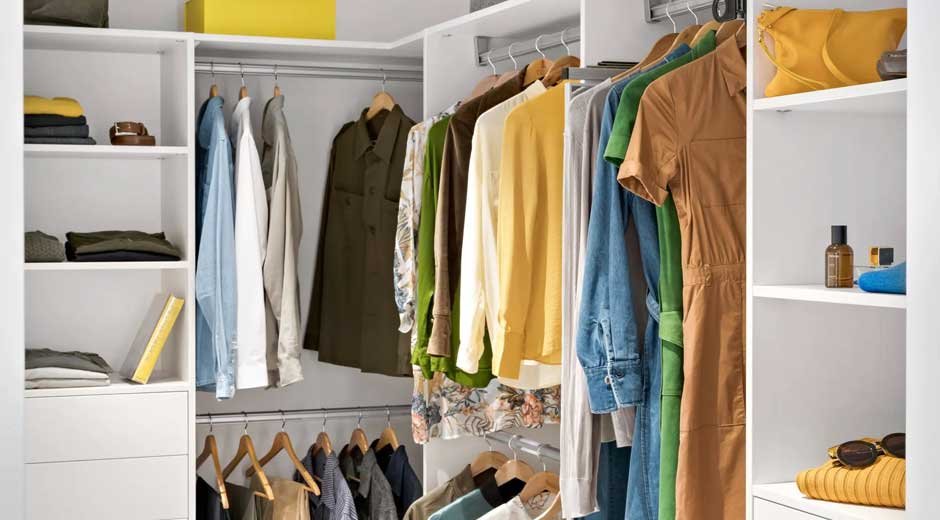Your wardrobe stores some of your most valued possessions and keeps them safe from dust and damage. But picking the right cupboard design that neatly arranges all your clothes while blending with your room décor can be confusing.
Customising storage according to your needs and preferences also involves some careful planning. But with a few practical tips and innovative ideas, you can create a wardrobe tailored to your space, storage requirements, and sense of aesthetics.
Read on for a handy guide that will simplify selecting a functional yet visually appealing clothes cupboard design. From layouts and dimensions to materials and styling, find answers to all your questions on what to consider when designing your dream wardrobe.
Factors to Consider for Choosing the Ideal Clothes Cupboard
Here are some essential factors to evaluate before diving into design options for your wardrobe.
1. Assess Your Requirements
Before looking at design options, analyse your existing storage and requirements:
- What kind of clothes do you own—work wear, casual wear, ethnic wear, winter wear, etc.? This will indicate the type of storage you need.
- How many family members need to share the storage space? Calculate per person storage volume required.
- What existing storage space do you have? Study your current cupboard – what’s working and what’s not?
- How much space can you allocate for the new cupboard? Take measurements.
This analysis will clarify your storage requirements—the number of compartments, shelves/drawers needed, the height and width of the cupboard, etc.
2. Choose a Location
Identify the best spot in your bedroom to place your clothes cupboard. Here are some tips for choosing the ideal location:
- It should not obstruct room circulation. Leave enough space to open doors and drawers fully without hindrance.
- You can opt for an in-built floor-to-ceiling cupboard for a spacious, luxurious look. This can also double as a room partition.
- Ensure proximity to changing area/full-length mirror if possible for convenience.
- The area should receive good natural lighting. Artificial lighting can also be installed inside the cupboard if needed.
- Airflow is essential to prevent dampness and mildew growth, so leave room around the cupboard for air circulation.
Measure the area where you want to erect the cupboard and mark out the dimensions. This will help visualise the right cupboard size for the space.
3. Select Design and Material
While planning your wardrobe design, consider the following elements:
● Structure
The options for cupboard structure include:
- Freestanding cupboards:These can be placed anywhere and don’t need wall attachments, so they offer flexibility when rearranging rooms.
- In-built cupboards:Customised for the room’s dimensions to utilise maximum space. A bespoke fitted look.
- Sliding door cupboards:Door panels slide along tracks instead of swinging open. Saves room space.
- Modular cupboards:These are flexible and customisable, and you can mix and match storage units like shelves, drawers, cabinets, etc.
● Storage Style
Along with regular shelves and cabinets, you can incorporate specialised storage units in your cupboard:
- Drawers are suitable for folding and stacking clothes and small clothing items and accessories.
- Hanging spaces, such as clothes rods/rails, should be provided for dresses, shirts, jackets, etc. Consider adjustable height rails.
- Deep drawers or walk-in units are used for off-season clothes, linen, etc.
- Shelves of varying heights and depths for shoes, bags, sweaters etc can be included.
- Add-ons like ties, belt racks, and jewellery trays can also be built-in.
● Material
For durability and visual appeal, suitable quality materials are a must for your dream cupboard:
- Wood, such as plywood, engineered wood, solid wood panels, etc., are great options as they offer smooth finishes and visual warmth. Go for termite/moisture-resistant wood.
- Laminates offer sheen and can replicate the look of premium materials like glass, stones, metals, etc., at pocket-friendly rates. They are also easy to clean.
- Steel has high tensile strength. Powder-coated steel with anti-rust properties is ideal for long-lasting performance and can hold heavy items.
- Glass/Acrylic doors look aesthetically pleasing and give a spacious feel.
4. Pick Suitable Add-ons
Well-designed customisations separate an ordinary cupboard from a smart, functional one. Based on your needs, you can consider incorporating features like:
- Adjustable/modular shelves and hanging rods
- Pull-out baskets
- Rotating tie-belt racks
- Chest of drawers
- Mirrors – full-length or foldable hand mirror
- Customisable storage boxes
- Soft-closing hinges for noiseless access
- Under cabinet LED lighting
- Charging docks for electronic items like hair straighteners, trimmers, etc
5. Choose a Style
Your clothes cupboard will be a focal point in the room. So opt for a style you love:
● Modern style
If you love clean, minimalist spaces, modern cupboards with sleek handles, gloss/matte finishes, concealed hinges, and lights will appeal to you. Glass doors enhance the contemporary vibe. Mix open and closed storage. Pair with a Lemon Yellow Colour Combination to add a refreshing and vibrant touch to the room’s overall aesthetics.
● Rustic style
Select wooden almirahs with visible wood grains and metal accents for a cosy, earthy look. Use vintage-style handles and opt for a distressed paint technique. Leave some shelves open to display collectables.
● Classic style
Do you prefer a traditional, ornate look? Solid wood cupboards with intricate carvings, classy cornices and mouldings, panelled doors and brass/crystal knobs spell understated luxury. Go monochrome or multi-hued.
6. Choose the Right Size
When deciding the dimensions of your cupboard, consider aspect ratios, i.e. height vs width vs depth.
- Decide on the height based on the ceiling height. Don’t exceed the room’s height; otherwise, the cupboard may look awkward. Allow for some clearance from the ceiling.
- Aim for width spanning the entire wall or at least 2/3rd of it for a streamlined look.
- The standard depth is 2 feet, but you can customise this. Shallower depths help save space.
Plan the shelves, rods, etc., layout to finalise internal dimensions. This will help estimate storage capacity accurately.
7. Decide on Budget
Prices for wardrobes vary based on choice of material, style and customisations. Wardrobes are available in different price segments:
- Economy-range wardrobes are the most affordable options
- Mid-range wardrobes balance functionality and aesthetics
- Premium designer wardrobes offer high-end materials and finishes
Reputed furniture stores also offer seasonal discounts. Do your research to get a rough idea of market rates for different materials in each segment.
8. Pick the Right Wardrobe Provider
Carefully research and shortlist manufacturers/carpenters specialising in wardrobe design. Some pointers while deciding:
- Check for good infrastructure, skilled artisans and the latest tools/equipment.
- Ensure they use branded fittings/accessories and weather/termite-resistant materials.
- Verify whether they have an in-house team for installation work.
- Choose providers offering extended warranty on their wardrobes.
- Review online ratings and read feedback from past clients.
- Compare pricing, lead times and post-installation support across shortlisted names.
This will help you find a reliable partner to translate your dream wardrobe design into reality.
Conclusion
A well-planned wardrobe makes mornings hassle-free and keeps your rooms neater. Before designing your ideal clothes cupboard, diligently evaluate your family’s clothing storage needs, space availability, preferred style, and budget. This ensures it suits your requirements perfectly while uplifting your room’s décor. Spend time researching suitable materials, features, dimensions, and a reliable wardrobe specialist for the best results. With some clever planning, you can build the clothes cupboard of your dreams.






